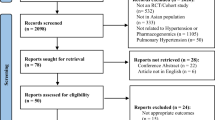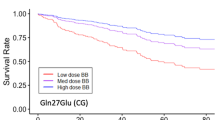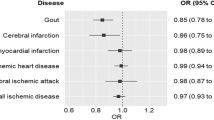Abstract
This study investigates whether the interaction between diuretics and alpha-adducin (ADD1) G460W or G-protein β3-subunit (GNB3) rs2301339 polymorphism modifies the risk of myocardial infarction (MI) or stroke. Data were used from the Rotterdam Study. The drug–gene interaction was determined with a Cox proportional hazard model with adjustment for each drug class as time-dependent covariates. The risk of MI in current users of low-ceiling diuretics with one or two copies of the ADD1 W-allele (hazard ration (HR)=0.92) was similar compared to the expected joint effect of the W-allele and low-ceiling diuretics on a multiplicative scale (1.04 × 0.90=0.94) (synergy index (SI):0.99; 95% confidence interval (CI): 0.43–2.27). No drug–gene interaction was found on the risk of stroke (SI:0.66; 95% CI:0.43–1.27). In addition, a trend towards an interaction was found between current use and the GNB3 rs230119 G/A polymorphism on the risk of MI (SI: 0.51; 95% CI: 0.23–1.15), whereas no interaction on the risk of stroke was found (SI: 0.84; 95% CI: 0.46–1.56).
This is a preview of subscription content, access via your institution
Access options
Subscribe to this journal
Receive 6 print issues and online access
$259.00 per year
only $43.17 per issue
Buy this article
- Purchase on Springer Link
- Instant access to full article PDF
Prices may be subject to local taxes which are calculated during checkout
Similar content being viewed by others
References
Whelton PK . Epidemiology of hypertension. Lancet 1994; 344 (8915): 101–106.
MacMahon S, Peto R, Cutler J, Collins R, Sorlie P, Neaton J et al. Blood pressure, stroke, and coronary heart disease. Part prolonged differences in blood pressure: prospective observational studies corrected for the regression dilution bias. Lancet 1990; 335 (8692): 765–774.
Fiebach NH, Hebert PR, Stampfer MJ, Colditz GA, Willett WC, Rosner B et al. A prospective study of high blood pressure and cardiovascular disease in women. Am J Epidemiol 1989; 130 (4): 646–654.
Whelton PK, Perneger TV, Brancati FL, Klag MJ . Epidemiology and prevention of blood pressure-related renal disease. J Hypertens Suppl 1992; 10 (7): S77–S84.
Neal B, MacMahon S, Chapman N . Effects of ACE-inhibitors, calcium channel blockers, and other blood-pressure-lowering drugs: results of prospectively designed overviews of randomized trials. Blood Pressure Lowering Treatment Trialists' Collaboration. Lancet 2000; 356 (9246): 1955–1964.
Manunta P, Cusi D, Barlassina C, Righetti M, Lanzani C, D'Amico M et al. Alpha-adducin polymorphisms and renal sodium handling in essential hypertensive patients. Kidney Int 1998; 53 (6): 1471–1478.
Psaty BM, Smith NL, Heckbert SR, Vos HL, Lemaitre RN, Reiner AP et al. Diuretic therapy, the alpha-adducin gene variant, and the risk of myocardial infarction or stroke in persons with treated hypertension. JAMA 2002; 287 (13): 1680–1689.
Davis BR, Arnett DK, Boerwinkle E, Ford CE, Leiendecker-Foster C, Miller MB et al. Antihypertensive therapy, the alpha-adducin polymorphism, and cardiovascular disease in high-risk hypertensive persons: the genetics of hypertension-associated treatment study. Pharmacogenomics J 2006 (in press).
Cusi D, Barlassina C, Azzani T, Casari G, Citterio L, Devoto M et al. Polymorphisms of alpha-adducin and salt sensitivity in patients with essential hypertension. Lancet 1997; 349 (9062): 1353–1357.
Glorioso N, Manunta P, Filigheddu F, Troffa C, Stella P, Barlassina C et al. The role of alpha-adducin polymorphism in blood pressure and sodium handling regulation may not be excluded by a negative association study. Hypertension 1999; 34 (4 Part 1): 649–654.
Sciarrone MT, Stella P, Barlassina C, Manunta P, Lanzani C, Bianchi G et al. ACE and alpha-adducin polymorphism as markers of individual response to diuretic therapy. Hypertension 2003; 41 (3): 398–403.
Turner ST, Chapman AB, Schwartz GL, Boerwinkle E . Effects of endothelial nitric oxide synthase, alpha-adducin, and other candidate gene polymorphisms on blood pressure response to hydrochlorothiazide. Am J Hypertens 2003; 16 (10): 834–839.
Neer EJ . Heterotrimeric G proteins: organizers of transmembrane signals. Cell 1995; 80 (2): 249–257.
Turner ST, Schwartz GL, Chapman AB, Boerwinkle E . C825T polymorphism of the G protein beta(3)-subunit and antihypertensive response to a thiazide diuretic. Hypertension 2001; 37 (2 Part 2): 739–743.
Hofman A, Grobbee DE, de Jong PT, van den Ouweland FA . Determinants of disease and disability in the elderly: the Rotterdam Elderly Study. Eur J Epidemiol 1991; 7: 403–422.
World Health Organization. International Classification of Diseases, 10th Revision (ICD-10). WHO: Switzerland; World Health Organization: Geneva, 1992.
Hollander M, Bots ML, Del Sol AI, Koudstaal PJ, Witteman JC, Grobbee DE et al. Carotid plaques increase the risk of stroke and subtypes of cerebral infarction in asymptomatic elderly: the Rotterdam study. Circulation 2002; 105: 2872–2877.
Anonymous. Guidelines for ATC Classification and DDD Assignment, 3rd edn. WHO collaborating Centre for drug statistics Methodology: Oslo, 2000.
van Duijn CM, de Knijff P, Cruts M, Wehnert A, Havekes LM, Hofman A et al. Apolipoprotein E4 allele in a population-based study of early-onset Alzheimer's disease. Nat Genet 1994; 7: 74–78.
Khoury MJ, Flanders WD . Nontraditional epidemiological approaches in the analysis of gene–environment interaction: case–control studies with no controls!. Am J Epidemiol 1996; 144: 207–213.
Acknowledgements
The Netherlands Heart Foundation financially supported this study, grant number: 2001.064. The Rotterdam Study is supported by the Erasmus Medical Center and Erasmus University Rotterdam, the Netherlands Organization for Scientific Research (NWO), the Netherlands Organization for Health Research and Development (ZonMw), the Research Institute for Diseases in the Elderly (RIDE), the Ministry of Education, Culture and Science, the Ministry of Health, Welfare and Sports, the European Commission (DG XII), the Municipality of Rotterdam, and the Centre for Medical Systems Biology (CMSB). The contributions of the general practitioners and pharmacists of the Ommoord district to the Rotterdam Study are gratefully acknowledged.
Author information
Authors and Affiliations
Corresponding author
Additional information
Duality of interest
None declared.
Rights and permissions
About this article
Cite this article
Schelleman, H., Klungel, O., Witteman, J. et al. Diuretic–gene interaction and the risk of myocardial infarction and stroke. Pharmacogenomics J 7, 346–352 (2007). https://doi.org/10.1038/sj.tpj.6500428
Received:
Revised:
Accepted:
Published:
Issue Date:
DOI: https://doi.org/10.1038/sj.tpj.6500428
Keywords
This article is cited by
-
The Rotterdam Study: 2012 objectives and design update
European Journal of Epidemiology (2011)
-
Genetic variants in the ADD1 and GNB3 genes and blood pressure response to potassium supplementation
Frontiers of Medicine in China (2010)
-
The Rotterdam Study: 2010 objectives and design update
European Journal of Epidemiology (2009)



